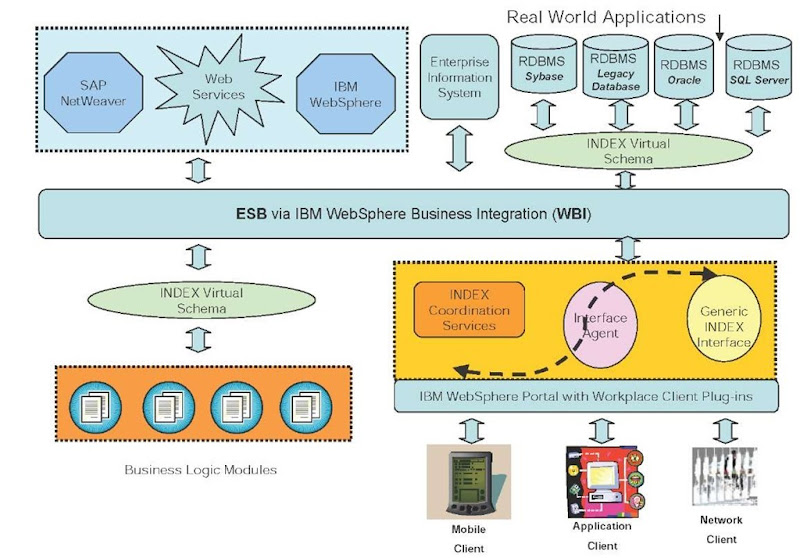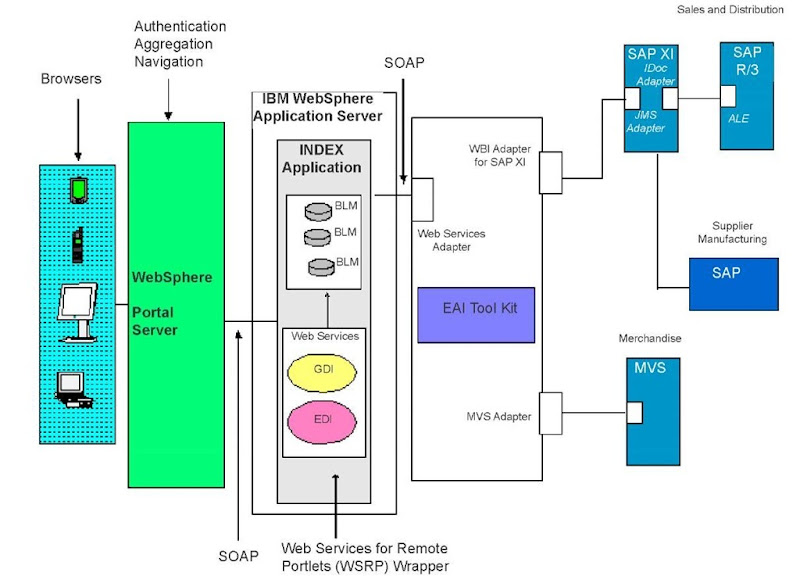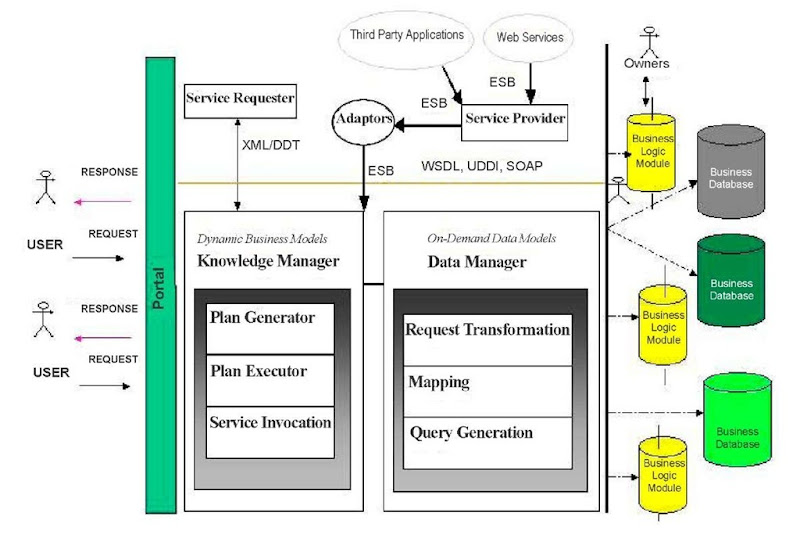INTRODUCTION
The increased use of online services in the commercial world has produced considerable impact on traditional technologies. Traditional information technologies were developed in an era where use of Internet technologies was not widespread. They have a long history and are often based on mature and stable technologies, or practices such as user interface design, artificial intelligence techniques, and so forth. In the era of e-business, business operations are often conducted in conjunction with business alliances and partners through networked activities. Internet (or Web-based) technologies are fulfilling an enabling role to meet the communication and collaboration requirements of e-business. In this article, we share our experiences in how traditional information technologies are coupled with Web-based technologies to gain much-needed leverage in offering e-business solutions. Portals, as the major communication media for Web users, offer opportunities for collaboration using multiple technologies. They also serve as mechanisms for integrating a variety of online services supported by traditional applications. In this article we will discuss the role of portals in application integration for online collaborative service delivery. Particular emphasis will be given to the marrying of the modern roles of portals in e-business with those roles where portals fulfil the traditional roles of front-end technologies. The article demonstrates its vision through a portal-based application integration solution framework associated with a typical application scenario. We demonstrate the effectiveness of using portals in application integration by employing an experimental framework implemented in the PHOENIX research project at Victoria University (http://www.staff.vu.edu.au/PHOENIX/phoenix/index1.htm).
RESEARCH PROJECT BACKGROUND TECHNOLOGIES
Before we describe our solution framework, we outline the background technologies used in our research project. These consist of portal technologies, knowledge management and Web services.
Portals Infrastructure
Portal solutions are heavily reliant on the use of existing applications and infrastructure to improve online services efficiency. Our framework is based on the logical architecture suggested by Britton (2001). This architecture contains three tiers—the presentation layer, the application server layer, and an enterprise information services layer.
The Presentation Layer
The main function of the presentation layer is to provide a unified view of results delivered by different applications that users usually view on browsers. There are common ways to render information content on the browsers such as HTML, plug-ins, applets, and portlets (Britton, 2001). Of these methods, we pay special attention to porlets. Portals use portlets as pluggable user interface components that provide a presentation layer and produce dynamic information displayed on the portal. They run on the Web server that provides content to the Web browser. Portlets also import different services offered by other applications to the front-end by determining the service features to be displayed on the user interface. Thus, portlets provide a bridge to the portal’s middle tier. Most portal construction software allows administrators to create their own customised portlets.
Application server layer
The presentation layer provides input to the application server layer. Application server refers to software residing beneath the Web server that handles the special designated tasks received by the Web server from end-users. In this layer, business rules are executed triggering possible application integration operations. The application server applies business solution logic and delivers the results back to the Web server before the results are sent to the users’ browsers. An application server usually works in an n-tier environment because it performs different roles at different levels. Some of the main roles that the application server provides include back-end application coordination and integration (e.g., applications for taking orders, credit checking, and fulfilling orders), and execution of business logic (e.g., related workflow) in response to users requirements. Some commercial vendors have combined the roles of Web server and application server in their products. For example, SAP Web application server combines the roles of standard Web server and application server.
Enterprise Information Services Layer
This layer contains enterprise information systems (EIS) such as CRM systems, database systems, and legacy systems (Britton, 2001). The systems can be located across company boundaries offering potential integration opportunities via a layered infrastructure of portal services.
WEB SERVICES
Web services is an emerging technology that supports application integration across the Internet. The Gartner Group (2001) defines a Web service as: “A software component that represents a business function (or a business service) and can be accessed by another application (a client, a server or another Web Service) over public networks using generally available ubiquitous protocols and transports (i.e. SOAP over HTTP).” That is, once a Web service is deployed, other applications (and other Web services) can discover and invoke the deployed service.
STANDARDS AND PROTOCOLS
The technical standard and protocols for portal applications are sharable with those for Web services. Thus portals and Web services can be combined to offer applications integration solutions across Internet. Some of these protocols and standards include:
WSRP
Web services for remote portlets (WSRP) is a standard that enables portals to access and display portlets that are hosted on a remote server. The WSRP specification defines a Web service interface for interacting with interactive presentation-oriented Web services. The motivations behind the WSRP functionality include: (a) allowing portal servers to provide portlets as presentation-oriented Web services that can be used by engines consuming Web services; (b) allowing portal servers to integrate services from different content providers into a portal framework.
WSDL
Web Services Description Language (WSDL) (Christensen et al., 2001) is used by Web services to describe available services. It provides an effective way for service providers to describe their services. A WSDL definition contains the information necessary for two systems to exchange Web service messages.
SOAP
Simple object access protocol (SOAP) is used for invoking Web services and is based on XML. It provides an envelope for sending and receiving XML data and documents. It allows program components and applications to interact with each other via the HTTP Internet protocol. SOAP is platform independent, does not depend on the programming language, is simple, flexible, and easily expandable.
KNOWLEDGE MANAGEMENT SYSTEM
INDEX (Dai & Wright, 1996) is the knowledge management system currently being used in the PHOENIX research proj -ect. It is used to coordinate application integration processes and to provide integration knowledge to management services. Integration knowledge guides the system in choosing and invoking the appropriate application packages or services in response to the tasks originating from the portal front-end. It is also used to deliver solutions back to the portal. The knowledge driven approach ensures that users’ requests and information services are processed and delivered intelligently. The core services INDEX provides include the goal-directed inference (GDI) and the event-driven inference (EDI). These provide services and knowledge editing facilities, which are deployed as Web services, thus allowing INDEX services and facilities to be assessable remotely across the Internet. GDI and EDI services cover a variety of tasks associated with users’ requirements. For instance, when users have well defined tasks in mind, GDI services such as fault diagnosis would be appropriate. If users do not know the specific tasks or problems, EDI could assist them by providing services such as alerts to management. The INDEX knowledge management system has the capability of communicating with external systems or application packages such as portals that serve as application front-ends.
online collaboration service delivery framework
The need to tie together incompatible enterprise systems has increased so greatly that many companies have shifted their IT focus from development to integration. Given the importance of integration, PHOENIX aims to leverage the service-oriented infrastructure for applications integration in order to build and generate user centric solutions and business specific applications. Consequently, on-demand solutions, such as improving business intelligence or finding better approaches in the supply chain of an organization, are produced through the collaboration of various solutions. These solutions are integrated by middleware. The middleware acts as the intermediary for software agents of components associated with applications connected to the business system by either wired or wireless networks. Without such integration, individual enterprise technology systems work in partially or completely autonomous environments thus limiting their effectiveness.
The aim of PHEONIX’s applied research is the delivery of innovative applications combining traditional and leading edge technologies that include application packages and products and services from leading vendors. The use of Portals plays several important roles in our research. Two of the more important roles are firstly, providing front-end Web-based user interface services and secondly, acting as a bridge for back-end application integration services. Figure
1 shows the high-level conceptual diagram associated with the applications oriented research. The figure shows client requests generated from various sources such as mobile devices and desktops. These requests are received via the portal and after processing results are returned to the clients via the portal. Thus, the portal plays the front-end role in receiving clients’ requests across the Web via interface agents (Dai & Abrahams, 2005) and delivering results to the clients. Having received a client query via the portal, the INDEX component, which provide the system’s coordination services invokes and executes the business logic modules (BLM) required in solving the specified problem. INDEX is deployed on multiple application servers each interacting with a Web server hosting a commercial portal product for which the University has license agreements with the relevant vendor. The two main commercial products are SAP Enterprise Portal and IBM WebSphere Portal. The consequence of executing business rules on BLM is a dynamic integration process binding different applications together behind a screen. In such a scenario, collaborative solutions are eventually delivered via portals.
Figure 2 presents a technical view of our application integration framework using SAP and IBM packages. INDEX integrates knowledge management and data management in one system. The main role of the data management module is to provide the required information via a dynamic problem solving process. Goal-directed inference (GDI) and event-driven inference (EDI), as well as the knowledge editing (back-end) facilities form the knowledge management module, which is powered by a plan generator and a plan executor. The plan generator produces solution plans for incoming tasks, and the plan executor applies the generated plans. GDI and EDI are deployed as Web services. These Web services are located on an IBM application server.
Figure 1. Conceptual diagram for the proposed applied research environment
Figure 2. Collaborative information delivery
The data management module is based on a database virtual schema and offers services that include user request transformation, mapping and query generations. The technical configuration of this module is shown in Figure 3.
Our PHEONIX framework is comparable to an architecture proposed by Firestone (2003) in his book on enterprise information portals and knowledge management. Our INDEX system plays a similar role to that played by the artificial information manager (AIM) layer in Firestone’s Portal for Application Integration (PAI) framework. However, we believe that the INDEX Web services as currently deployed through GDI and EDI are more scalable and flexible than Firestone’s framework. This is because INDEX technologies have specially been designed to work collaboratively with existing technologies (e.g., third party applications via connectors and adaptors) and practices. That is, our research proj ect aims to deliver collaborative Web-based applications that work effectively with existing applications including commercial products and tools.
FUTURE TRENDS
The increased use of online information services will see Web-based client programs gradually replace traditional application user interface programs. Development standards will also become more unified. Portals, due to their unique features, will play an increasingly important role in offering user interface services. Portals’ successes will also ultimately depend on the progress of application integration across the Internet using Web services. In future research, we will extend existing plug-in concepts and scope to al- low application modules and data sources to be integrated dynamically on demand.
Figure 3. Collaborative information services
CONCLUSION
This article discussed the relevance of Web-based technologies, in particular, portal technologies, to e-business. It reviewed background technologies relevant to portal operations and deployment, and emphasised the importance of application integration, especially with traditional existing technologies. We discussed the role of portals as both a front-end interface with users and as a vehicle for back-end integration with different applications. We presented the PHEONIX solution framework to demonstrate the use of portals. Related work has also been discussed.
KEY TERMS
Application Server: Refers to software residing beneath the Web server to handle the special designated tasks received by the Web server from end-users according to business logic.
Event-Driven Inference (EDI): An inference component of INDEX knowledge management system, which is deployed as a Web service.
Goal-Directed Inference (GDI): An inference component of INDEX knowledge management system, which is deployed as a Web service.
HyperText Transfer Protocol (HTTP): Defines how messages should be formatted and transmitted across Internet.
Portlets: These are Web components that process requests and generate dynamic content for portals. Portals use portlets as pluggable user interface components that provide a presentation layer to information systems.
Simple Object Access Protocol (SOAP): Used for invoking Web services. It provides an envelope for sending and receiving XML data and documents.
Web Services for Remote Portlets (WSRP): A standard for portals to access and display portlets that are hosted on a remote server.



